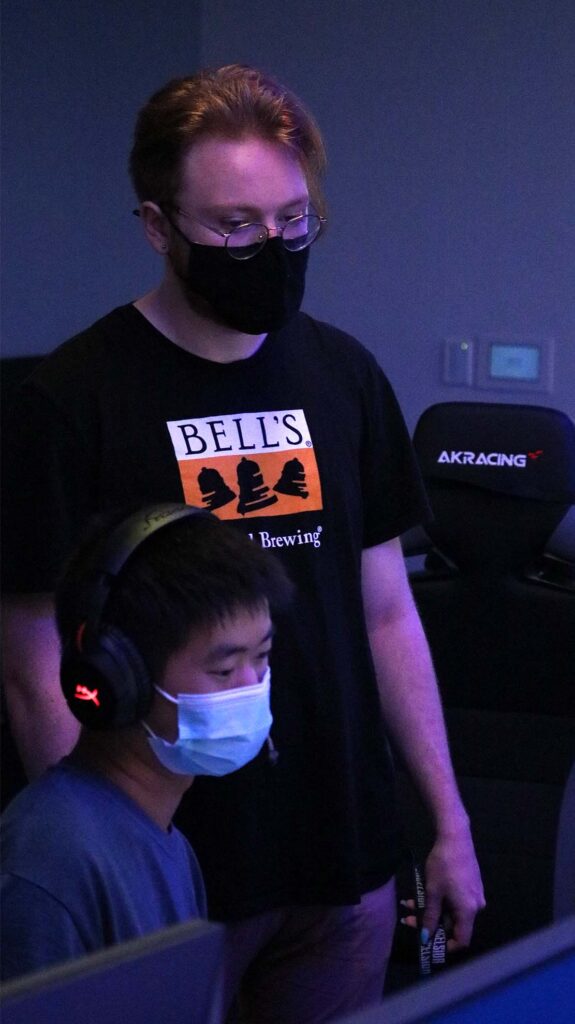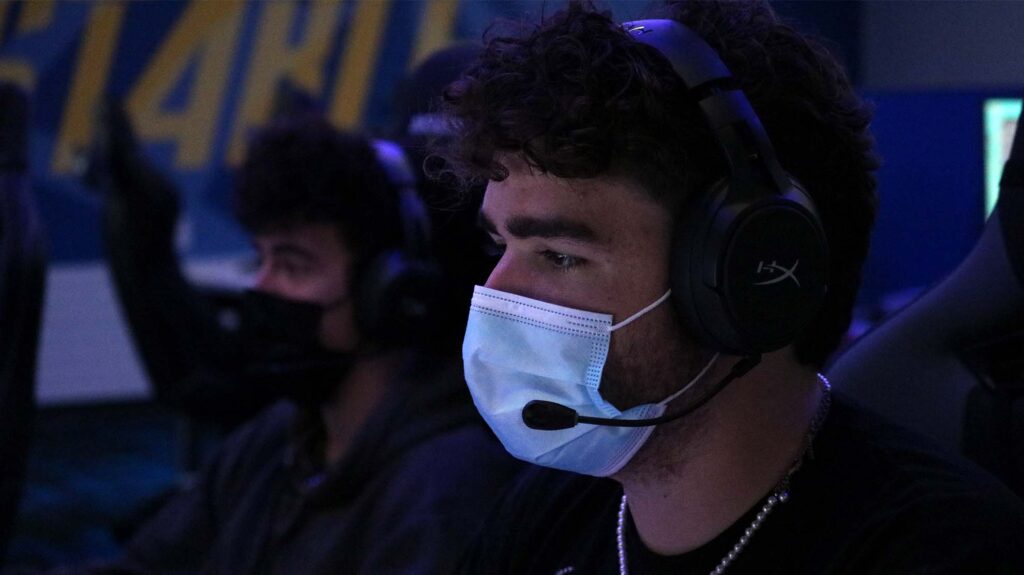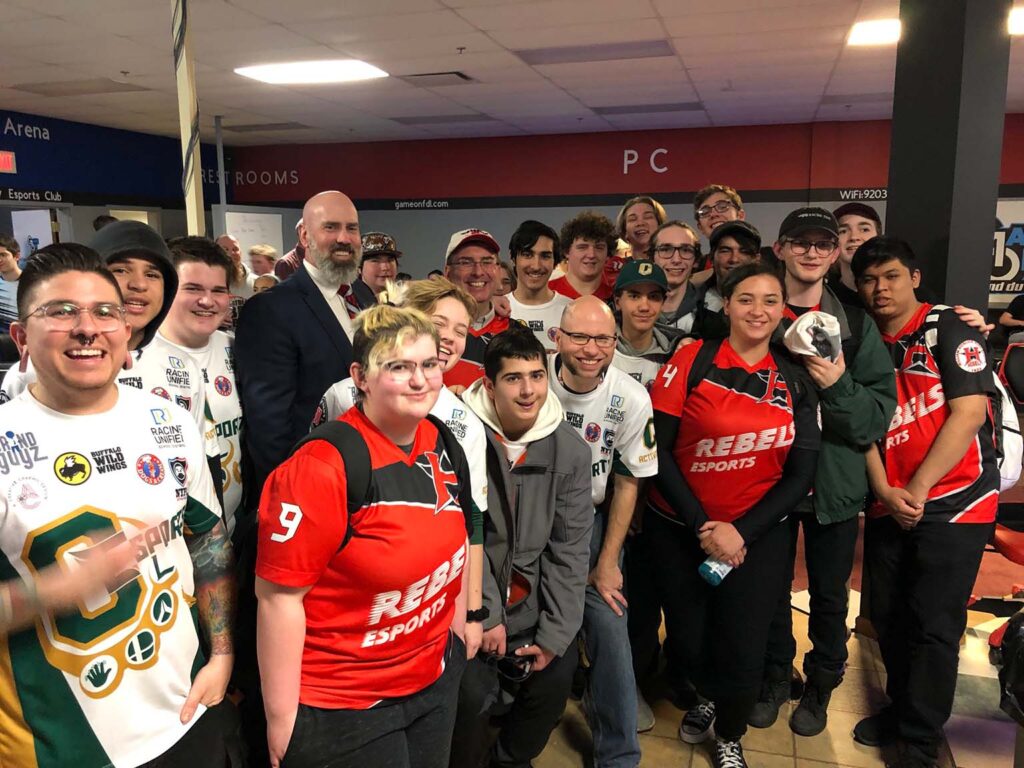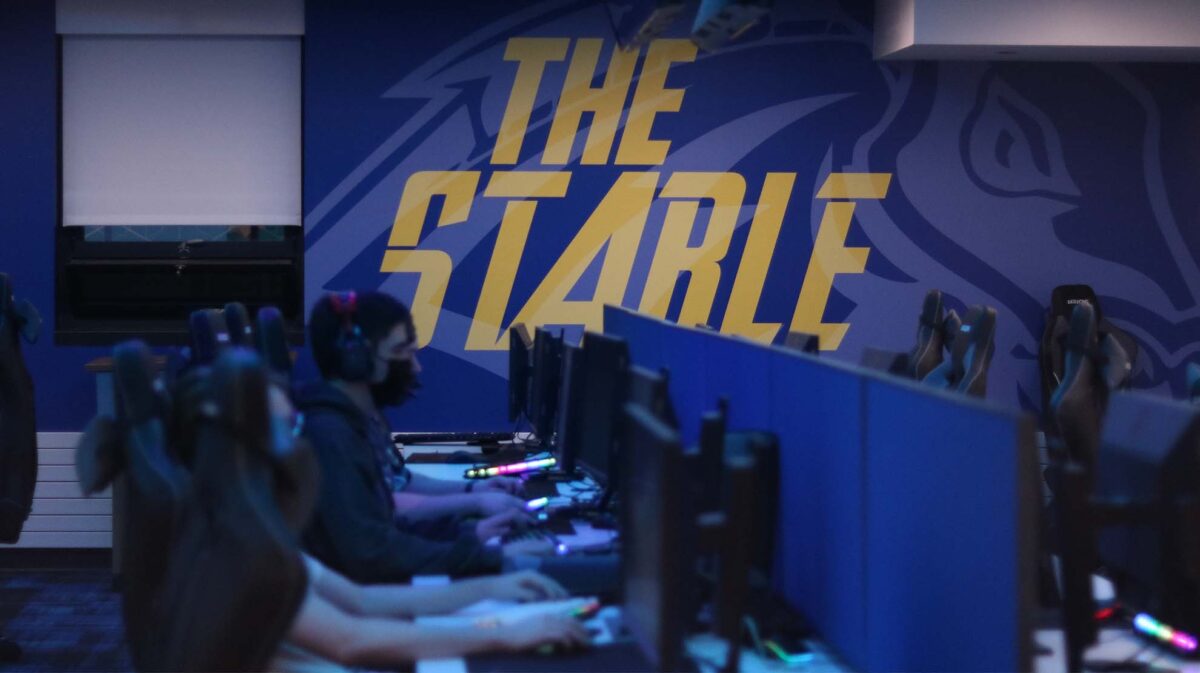Through keyboards clacking and wide eyes staring at computer monitors, the dedication to playing video games can be seen through every inch of The Stable, the University of New Haven’s esports suite.
Players can be heard barking commands at their teammates as they become completely engaged in their screens. Faces are focusing on every single frame that whizzes by them as they try to keep up with the break-neck speed of the video games that they play.
Located inside Buckman Hall, the suite is where these players congregate to compete at a high level. To them, video games are more than just a hobby. When competing against some of the best college players in the region, any minor mistake can be the difference between a nail-biting win and a soul-crushing defeat.

That high level of play can be a lot for many casual players to handle, but for Jarrod Palladino, a player on the UNH varsity League of Legends team, the competitive drive comes naturally.
“Whenever I play games, I have a really hard time not taking them competitively, and it just seemed like the natural progression to join a team after that,” Palladino said.
Palladino started his esports journey with Overwatch, the 2016 first-person shooter developed by Blizzard Entertainment, where his skill caught the eye of Team Calamity, an amateur team that was only competing in small tournaments.
But despite the tournaments’ lack of a large cash prize for the winner, Palladino was energized by the thrill of competing.
“Being competitive and having like those high-intensity playoff matches is so intense, and it’s so much fun to do,” Palladino said.
After a few years went by, Palladino lost his love for Overwatch. He soon transitioned to League of Legends, a five-versus-five game where players are divided into roles — top laner, mid laner, bot laner, jungler and support — to battle inside a massive arena.
As Palladino got better at League, he decided to join his high school’s team in Shrewsbury, Massachusetts, as a mid laner. While they didn’t have the school’s full support and the team was run by a teacher who knew little about the game, Palladino and his teammates fought their way to win the school’s fifth state championship in as many years.
Many of the UNH players followed a similar path in their journey to competitive League: start playing the game with friends, get good at it, join a high school or amatuer team and then go to UNH to play for the varsity team.
But the level of skill needed to compete with the best universities in the region doesn’t come easy, so the team practices for dozens of hours every week.
“I know plenty of people who spend 50, 60 hours a week, even more, just constantly playing, trying to practice, and you have to keep up with that,” top laner Elliot Starr said. “And you might not have that much time to spend, but it’s using that time effectively and really focusing on improving.”
During the fall season, the team practices together for three hours each day, four days a week. The team also spends one day to go over film of its previous games to address areas of improvement.

Outside of class and those scheduled times, the players said they spend a lot of their time playing on their own.
“In our off time, we are always competing, trying to get better individually as a player,” bot laner Owen Bailey said. “A lot of grinding goes into the game. It’s more than just that little block that you’re playing other teams. It’s a big grind like other sports.”
Bailey said that it’s easy to lose focus of the big picture behind the hundreds of hours of dedication required to compete, especially when the passion for the game came from a place of entertainment, not competition.
“I think the biggest difference, for me at least, is knowing how to turn off your for-fun switch and adjusting to trying to play the game at your peak performance all the time,” Bailey said. “I started playing this game purely for fun. … Stopping that and fully competing at the highest level you, as an individual, can, it’s probably the hardest part for me.”
While long hours and the stress of competition can sometimes lead to heated arguments, the players say that the team has been a wonderful experience, and they have become closer as friends because of it.
Jungler Joey Sciotto even invited the rest of the team to his home in Long Island for a summer weekend together before the fall semester, and their season, began.
“It’s been a good time,” Palladino said. “I feel like I’ve made some of my best friends on this team.”
Learning while they play
People always ask me ‘Is esports a sport?’ I say, ‘Look, it has fans, it has revenue and it’s growing. It’s a business.’
Jason Chung, executive director of esports at UNH
When these players aren’t busy competing in esports, they’re learning about the industry in class.
In 2019, the university began offering a bachelor of science in esports and gaming, as well as the first Master’s degree in esports in the U.S. The degrees offer classes covering the business of esports, including marketing, event management and entrepreneurship.
Executive Director of Esports Jason Chung said the need for the programs came from a need of highly educated young people in the industry.
“I mean, a lot of the industry actually was asking for it,” Chung said. “There’s a lot of passionate people that want to go into esports, but [companies] also want people with the education and the background to come work at entry, mid and executive positions. … We know that the desire to engage with students is very, very strong.”
According to Juniper Research, the video games market is projected to surpass $200 billion by 2023, while esports, a smaller piece of the video gaming pie, is estimated at just over $1 billion in 2021, and is projected to reach $1.6 billion by 2024, according to a report by Newzoo.
With more money coming into the industry, companies are expanding and creating new positions. From 2018 to 2019, the number of paid esports jobs grew from 4,591 to 9,705 — a 111.39% increase — according to Hitmarker.
“The reason why people are interested in esports is because it’s growing (in fans), but also as a business,” Chung said. “It’s gone from a few 100 million dollars a year (to crossing) the billion-dollar threshold, but it’s still such a tiny slice of the overall gaming market.”
Chung pointed to the students’ in-class workshops with companies in the industries like gaming gear brand HyperX, gaming streaming platform Twitch and sports broadcasting company Turner Sports.
Players said the programs are great for their career aspirations in esports, even if it means not actually playing competitively.
Bailey, Sciotto and Starr said they are interested in either coaching, managing or playing for a professional League team. Starr said that while it may be a long shot to play competitively for an organization, his major will prepare him for a job elsewhere in the industry.
From software engineering to social media management, there is a wide range of jobs that young workers are looking to transfer their skills into, and Starr said his main goal is to find work in the industry that he loves.
“I had really, really big dreams to go pro, or at least semi pro,” Starr said. “I know it’s probably super unlikely to happen, so … if I can’t, this is what I’m gonna do, which is more than likely because I want to be in the scene.”
But Bailey said that while the players may have aspirations outside competing, the blood, sweat and tears that has been put into the games by them isn’t just for show.
“I think a big part of the esports program, even as an individual player, is if you can’t go pro or you want to go pro, there’s so many things you could gain out of it,” Bailey said. “You gain the experience of competition, like a semi high level, and you also get a lot of connections. … We’re already starting to grow our network.”
Throughout the U.S., other universities are looking to include classes about esports and the video game industry in their course catalogs. In Connecticut, Quinnipiac University and the University of Connecticut have both offered classes that cover topics like esports journalism, multiplayer game design and more.
However, gaming education doesn’t just start at the college level. In Groton, Connecticut, the public schools’ Director of Technology Clint Kennedy is looking to converge esports and education.
Coming from an educational background instead of a gaming one, he was looking to help his students in any way possible. Esports, he found, did exactly that.
“I love the games, but the point of all this, other than engaging students. is to give them experiences so that they can build skills, knowledge and habits of mind around these identified constructs … which I think can allow them to be successful in a career (and) in life,” Kennedy said.
Students can now play in competitive, statewide esports leagues, but there are also plenty of other options for those who don’t want to compete. Experience in broadcast journalism, coaching and team management are some of the things Kennedy said that Groton is looking to give its students.
With the program offering many different leadership positions, Kennedy said it helps attract students with a wide variety of interests.
“My goal would be that there’s an opportunity (in esports) for any high school student across the country, regardless of who they are, their background, their experiences or where they come from,” Kennedy said.
Finding a family through gaming
We’ve given them connections that they never would have made, we’ve helped them build their support networks. That’s what keeps bringing me back to this.
James O’Hagan, director of digital and virtual learning for Racine Unified
One in every five people in Racine, Wisconsin, live in poverty — double the national average. It’s a fact that is felt throughout the entire city and county, as well, but it hits hardest in the public schools.
With an absenteeism rate of 27.4%, nearly twice that of the state’s, the Racine Unified School District has a hard time getting students to consistently show up to class.
James O’Hagan, RUSD director of digital and virtual learning for Racine United, was tasked with fixing this issue head on.
Coming from a wide background of working in multiple grade levels with students of varying backgrounds and needs, he knew one key way to engage with kids.
“I had always been a gamer,” O’Hagan said. “I was an elementary school teacher for many years, middle and high school, … but everything with all this always came back to games and gameplay. That was the time I could engage the kids the most.”
According to an August 2021 report by Newzoo, 81% of Gen Z reported that they played video games within the past six months and average seven hours and 20 minutes of game time a week.
On top of that, 40% of those respondents stated that they use gaming “in more social- and community-based ways” to hang out with friends and form close online connections.
With that, O’Hagan set out to establish gaming clubs and communities inside high schools to foster positive teacher-student relations and make kids feel excited about going to school.

The ideas O’Hagan had with integrating esports and gaming into learning came to life while he began working as director of instructional technology for Rockford, Illinois, public schools in 2014.
Only about an hour outside of Rockford, Robert Morris University Illinois was giving esports scholarships to students. O’Hagan saw that as an opportunity.
He worked with the athletic director of Rockford’s district to create extracurricular activities surrounding gaming and esports. O’Hagan said they engaged with kids who the schools’ other sports had not reached for years.
In 2015, O’Hagan moved to Racine and began his work with the RUSD, but he kept the same priorities that he had at Rockford — helping the kids. By building positive interactions between educators and students, O’Hagan said, students who were left behind or felt unwelcome can have an inclusive space to socialize in.
“The athletic culture that we have in this country has been pigeonholed into very specific things,” O’Hagan said. “We have really ignored some of the things that really get kids in the door a lot of times, and that’s where athletics, drama, music, arts and games now are things that are helping to drive our kids into our schools and make them feel a part of the school culture.”
Ernesto Dagnino is a high school senior at Racine, and while he didn’t get bad grades, he found traditional schooling quite boring. As a digital artist and a gamer, he was more interested in doing the things he loved.
Hi! I’m Nes, I’m 17 and I make this stuff and so much more. pic.twitter.com/ue3ivjkl4X
— Nes (@nesulosity) October 28, 2021
When the RUSD’s esports program started up during his sophomore year, Dagnino and his friends joined as a way to enjoy this hobby with other students. But as the months moved on, Dagnino got more and more involved. By making logos, jerseys and graphics for the teams, Dagnino eventually took up a leadership role.
Through his three years in the program, Dagnino said he was introduced to an industry he didn’t originally consider a career in.
“Truthfully, I never really saw it as something that I could do until (I joined) the program,” Dagnino said. “I think there’s a lot of potential there creatively for me to employ those skills that I have into several different things that really interest me.”
As a senior, Dagnino has applied to the Milwaukee Institute of Art & Design and other colleges. He said he not only wants to continue his dream of being a commercial illustrator, but he also wants to explore computer programming and web development.

Not only did the program open Dagnino’s eyes to a new career path, he said, but it also provided a very inclusive and positive environment for students.
“I think just looking at the bigger picture of the whole program, I do see a whole lot of comradery, even across teams,” Dagnino said. “I don’t know if I’ve ever seen two different high school (sports) teams coming together after a game being like ‘Hey, great game, that was a lot of fun. You guys want to go hang out after school?’ But that’s totally different for esports.”
That inclusivity was especially important for players and students in the LGBTQ community.
“I think the program has also done a really good job at addressing our LGBTQ students,” Dagnino said. “I actually have a handful of members on my team … who are trans, two of which who are bisexual. I have another really good friend of mine, on another team, who’s also trans. I talked with Mr. O’Hagan about how we can help other people a lot more. He has been super gracious in helping us figure out and super accepting and understanding.”
But O’Hagan credits Dagnino with educating him on the importance of many LGBTQ issues, to the point where O’Hagan said he felt impassioned enough to stand up for any decision the program would make.
Even something as seemingly minor as letting students choose their preferred pronouns in the program’s online chat board, O’Hagan said, was a decision that has let students feel seen.
“It was not that I didn’t want to do it, it was just I needed to make sure that I had questions answered (in case) I got asked,” O’Hagan said. “(Dagnino) was one of those people who really turned it around and educated me. I learned so much from him just in that experience alone that it’s impacted me beyond esports even.”
As esports and programs such as the ones in New Haven, Groton and Racine continue to expand, O’Hagan said he sees a bright future for the many young students who these programs have helped.
But while schools should continue to invest in esports and gaming programs, O’Hagan said they shouldn’t lose sight of what’s most important when making those decisions.
“This is not about what league you choose or even what games you play … it all comes back to the kids (being) at the core of all this,” O’Hagan said.
Kennedy shared a similar sentiment, and he also noted that while esports in public schools has come a long way in regard to its growth, there is still a lot of minds that have to be changed.
With the stereotypes of Mountain Dew-drinking and Cheetos-eating gamers, Kennedy said that not everyone sees the truth behind esports.
“We have not convinced everyone of the of the value of it yet, and that’s what I what I try to talk about as often as I can,” Kennedy said. “I love the games personally, and I’ve seen students enjoy them for face value of what they are. But I also seen the engagement it’s brought certain students that don’t necessarily have a natural way to find a community or get engaged.”
Even without complete validation, these esports students say the programs that they have called home have helped them a lot.
University students will soon graduate with degrees in an industry that would have seemed improbable only a decade ago. High school students will leave with a new door open to them.
Time will tell if these programs and classes will provide jobs and expand the industry, but for the time being, students will continue to pursue doing what they love.


One reply on “Esports is entering schools across the U.S., but students are doing more than playing games”
Keep up this amazing work! I enjoyed reading it